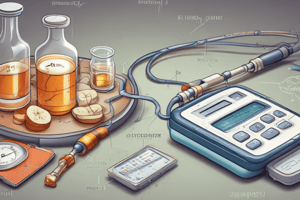Podcast
Questions and Answers
Following overnight fasting, hypoglycemia in adults is defined as a glucose of:
Following overnight fasting, hypoglycemia in adults is defined as a glucose of:
- < or equal 70 mg/dL (<=3.9 mmol/L)
- <= 60mg/dL (<=3.3 mmol/L)
- <= 55mg/dL (<=3.0 mmol/L)
- <=45 mg/dL (<=2.5 mmol/L) (correct)
The following results are from a 21-year old patient with a back injury who appears otherwise healthy:
Whole Blood Glu : 77mg/dL (4.2 mmol/L)
Serum Blood Glu: 88 mg/dL (4.8mmol/L)
CSF glucose: 56 mg/dL (3.1 mmol/L)
The best interpretation of these results is that:
The following results are from a 21-year old patient with a back injury who appears otherwise healthy: Whole Blood Glu : 77mg/dL (4.2 mmol/L) Serum Blood Glu: 88 mg/dL (4.8mmol/L) CSF glucose: 56 mg/dL (3.1 mmol/L) The best interpretation of these results is that:
- the whole blood and serum values are expected but the CSF value is elevated
- the whole blood glucose value should be higher than the serum value
- all values are consistent with a normal healthy individual (correct)
- the serum and whole blood values should be identical
The preparation of a patient for standard glucose tolerance testing should include:
The preparation of a patient for standard glucose tolerance testing should include:
- a high carbohydrate diet for 3 days (correct)
- a low carbohydrate diet for 3 days
- fasting for 48 hours prior to testing
- bed rest for 3 days
If a fasting glucose was 90 mg/dL, which of the following 2-hour postprandial glucose results would most closely represent normal glucose metabolism?
If a fasting glucose was 90 mg/dL, which of the following 2-hour postprandial glucose results would most closely represent normal glucose metabolism?
A healthy person with a blood glucose of 80 mg/dL (4.4 mmol/L) would have a simultaneously determined cerebrospinal fluid glucose value of:
A healthy person with a blood glucose of 80 mg/dL (4.4 mmol/L) would have a simultaneously determined cerebrospinal fluid glucose value of:
A 25-year old man became nauseated and vomited 90 minutes after receiving a standard 75 g carbohydrate dose for an oral glucose tolerance test. The best course of action is to:
A 25-year old man became nauseated and vomited 90 minutes after receiving a standard 75 g carbohydrate dose for an oral glucose tolerance test. The best course of action is to:
Cerebrospinal fluid for glucose assay should be:
Cerebrospinal fluid for glucose assay should be:
Which of the following 2 hour postprandial glucose values demonstrates unequivocal hyperglycemia diagnostic for diabetes mellitus?
Which of the following 2 hour postprandial glucose values demonstrates unequivocal hyperglycemia diagnostic for diabetes mellitus?
Serum levels that define hypoglycemia in pre-term or low birth weight infants are:
Serum levels that define hypoglycemia in pre-term or low birth weight infants are:
A 45-year-old woman has a fasting serum glucose concentration of 95 mg/dL (5.2 mmol/L) and a 2-hour-postprandial glucose concentration of 105 mg/dL (5.8 mmol/L). The statement which best describes this patient's fasting serum glucose concentration is:
A 45-year-old woman has a fasting serum glucose concentration of 95 mg/dL (5.2 mmol/L) and a 2-hour-postprandial glucose concentration of 105 mg/dL (5.8 mmol/L). The statement which best describes this patient's fasting serum glucose concentration is:
Pregnant women with symptoms of thirst, frequent urination or unexplained weight loss should have which of the following tests performed?
Pregnant women with symptoms of thirst, frequent urination or unexplained weight loss should have which of the following tests performed?
In the fasting state, the arterial and capillary blood glucose concentration varies from the venous glucose concentration by approximately how many mg/dL (mmol/L)?
In the fasting state, the arterial and capillary blood glucose concentration varies from the venous glucose concentration by approximately how many mg/dL (mmol/L)?
The conversion of glucose or other hexoses into lactate or pyruvate is called:
The conversion of glucose or other hexoses into lactate or pyruvate is called:
Flashcards are hidden until you start studying
Study Notes
Glucose Measurement
- Hypoglycemia in adults is defined as a glucose level below 70 mg/dL (3.9 mmol/L) after an overnight fast.
- In the given patient, whole blood glucose is 77 mg/dL (4.2 mmol/L), serum blood glucose is 88 mg/dL (4.8 mmol/L), and CSF glucose is 56 mg/dL (3.1 mmol/L).
Glucose Tolerance Testing
- Preparation for standard glucose tolerance testing includes overnight fasting.
- A fasting glucose of 90 mg/dL (5 mmol/L) would correspond to a 2-hour postprandial glucose result of around 140 mg/dL (7.8 mmol/L) for normal glucose metabolism.
Cerebrospinal Fluid (CSF) Glucose
- A healthy person with a blood glucose of 80 mg/dL (4.4 mmol/L) would have a CSF glucose value of around 60-70 mg/dL (3.3-3.9 mmol/L).
- CSF for glucose assay should be collected in a fluoride-containing tube to inhibit glycolysis.
Oral Glucose Tolerance Test (OGTT)
- If a patient becomes nauseated and vomits 90 minutes after receiving a standard 75 g carbohydrate dose for an OGTT, the test should be stopped and restarted at a later time.
Diabetes Diagnosis
- A 2-hour postprandial glucose value of 200 mg/dL (11.1 mmol/L) or higher demonstrates unequivocal hyperglycemia diagnostic for diabetes mellitus.
Hypoglycemia in Infants
- Serum levels that define hypoglycemia in pre-term or low birth weight infants are below 40 mg/dL (2.2 mmol/L).
Glucose Concentrations
- A fasting serum glucose concentration of 95 mg/dL (5.2 mmol/L) is considered impaired fasting glucose.
- Pregnant women with symptoms of thirst, frequent urination, or unexplained weight loss should have a 2-hour OGTT performed.
Blood Glucose Variations
- In the fasting state, arterial and capillary blood glucose concentrations vary from venous glucose concentration by approximately 5-10 mg/dL (0.3-0.6 mmol/L).
Glycolysis
- The conversion of glucose or other hexoses into lactate or pyruvate is called glycolysis.
Studying That Suits You
Use AI to generate personalized quizzes and flashcards to suit your learning preferences.



